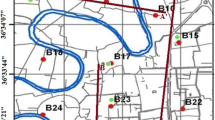Abstract
Caracas 1967 earthquake caused heavy damage to multi-story buildings. In 1995, 184 microtremor measurement points were performed over the city. The measurement grid was more or less dense and covered the main part of the alluvial basin as well as surrounding rock basement. For each point, the horizontal record spectrum was divided by the vertical one (H/V ratio). Subsequently, the strongest value (Ao) of this ratio in a given frequency band was kept, as well as the frequency (Fo) where it occurred. Spatial interpolations of Ao and Fo were performed among all points of Palos Grandes district. A map was plotted representing a single surface where Ao is relief and Fo is represented by grey gradation. An alluvion thickness (H) map can be compared with this result. Damaged buildings are located on the same map. Fo decreases until 0.6 Hz when alluvion thickness (H) increases. Fo values fit with frequencies previously predicted from computation and with 1967 earthquake observations. Moreover, interpolation surfaces show that amplification (Ao) of H/V on microtremor is quite low above rock but is high on the south part of the basin. The maximum occurs over the non-urbanized zone. However the other area, where Ao is higher than 5, roughly corresponds to the location of the four collapsed buildings. Furthermore, the estimated natural frequency of these buildings was around Fo. Graphics showing H, Fo and Ao evolution through the basin were composed. Links between all these values are noticeable. Fo is claimed to be very similar to the resonance frequency of soil. As for Ao, it could be a fairly relevant sign of damage seriousness. Microtremor technique is an economic tool and it allows measurement grid as dense as desired. H/V ratio processing followed by interpolation of maximum values provides precise and useful information about expected site effect.
Access this chapter
Tax calculation will be finalised at checkout
Purchases are for personal use only
Preview
Unable to display preview. Download preview PDF.
Similar content being viewed by others
References
Reports for Republic of Venezuela, under the planning and supervision of the Presidential Commission for the study of the Earthquake:
Bolton Seed H., Idriss, I. M., Dezfulian, H. (1970), Relationships between soil conditions and building damage in the Caracas Earthquake of July 29, 1967. In Report N°EERC 70–2, College of Engineering University of California, Berkeley, California, Feb. 1970.
Weston Inc. (1969), Seismic Investigations in the Valley of Caracas and the Lithoral Central, Weston Geophysical Engineers International, Inc. (Weston, Massachusetts, Aug. 1969).
Whitman, R. V. (1969), Effect of Soil Conditions Upon Damage to Structures — Caracas Earthquake of 29 July 1967, Robert V. Whitman, Massachusetts Institut of Technology, Nov. 1969.
Others References
Bolton Seed, H., Whitman, R. V., Dezfulian, H., Dobry, R., and Idriss, I. M. (1972), Relationships between soil conditions and building damage in the 1967 Caracas Earthquake; J. Soil Mechanics and Foundations Division, ASCE.:
Duval, A.-M., Méneroud, J.-P., Vidal, S., and Bard, P.-Y. (1994), Usefulness of microtremor measurements for site effect studies. In Proc. Tenth European Conf. Earthquake Engin., Vienna, Austria, EAEE, Aug. 1994, vol. 1, 521 pp.
Duval, A.-M. (1996), Détermination de la réponse d’un site aux séismes à l’aide du bruit de fond, Evaluation expérimentale, Etudes et Recherches des Laboratories des Ponts et Chaussées, Série Géotechnique — GT 62-LCPC, ISBN 2–7208–2480–1, in French, 264 pp.
Lachet, C. and Bard, P.-Y. (1994), Numerical and Theoretical Investigations on the Possibilities and Limitations of Nakamura’s Technique, J. Physics of the Earth 42, 377–397.
Nakamura, Y. (1989), A Method for Dynamic Characteristics Estimation of Subsurface Using Microtremor on the Ground Surface. QR of RTRI 30, 25–33.
Nogoshi, M. and Igarashi, T. (1971), On the Amplitude Characteristics of Microtremor (Part 2), J. Seismol. Soc. Japan, 24, 26–40.
Author information
Authors and Affiliations
Editor information
Editors and Affiliations
Rights and permissions
Copyright information
© 2002 Springer Basel AG
About this chapter
Cite this chapter
Duval, AM. et al. (2002). Caracas, Venezuela, Site Effect Determination with Microtremors. In: Roca, A., Oliveira, C. (eds) Earthquake Microzoning. Pageoph Topical Volumes. Birkhäuser, Basel. https://doi.org/10.1007/978-3-0348-8177-7_14
Download citation
DOI: https://doi.org/10.1007/978-3-0348-8177-7_14
Publisher Name: Birkhäuser, Basel
Print ISBN: 978-3-7643-6652-0
Online ISBN: 978-3-0348-8177-7
eBook Packages: Springer Book Archive




